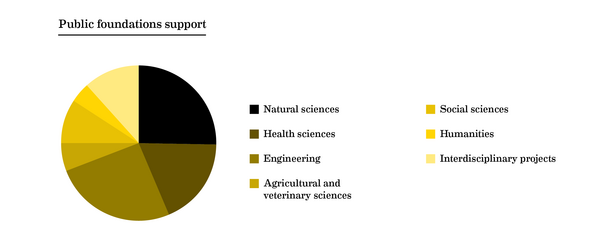He who pays the piper calls the tune. A guide to the research funding landscape in Denmark
Where does it come from? The money that pays for research in Denmark. Some of it is allocated by politicians every year. Some of it by foundations, public and private. In this series of articles, Omnibus guides you through the research funding landscape in Denmark.

The money to finance research comes from a variety of sources. At the most general level, we can distinguish between funding from public and private sources. To take public sources first, this is what’s known as the ‘public research budget’. In other words, taxpayer’s money that’s spent on research. The three types of public research funding in Denmark are national (state), regional and municipal.
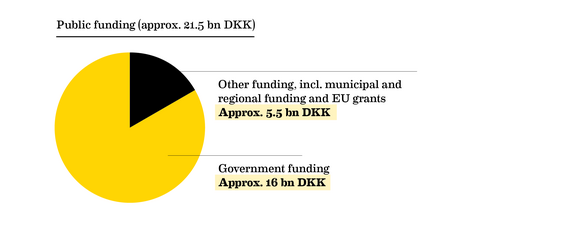
Here we’ll be focussing on national funding. The amount of money earmarked for research is decided by the Danish Parliament each autumn when the Finance Act for the coming year is adopted. In recent years, politicians have appropriated about 16 billion kroner annually for research.
Basic funding
About half of government research funding is disbursed as basic funding to the universities – in other words, funding the universities are free to allocate as they see fit. While eight billion kroner might sound like a lot, in reality far from all of this money can be spent on research. What’s more, some of this basic funding is tied to a co-financing requirement: it’s conditional on researchers receiving grants from private foundations. For example, if a foundation like Novo Nordisk grants 5 million kroner to a research project at AU, some of AU’s basic funding may be spent on financing materials, maintaining equipment and staff for the project.

While it’s difficult to get a clear sense of what proportion of basic funding is spent in this way, Senior Researcher Kaare Aagard from the Danish Centre for Studies in Research and Research Policy estimates – based on what he characterises as a very rough estimate – that at least half of basic funding goes to a variety of costs other than independent research projects initiated by researchers. This means we’re down to about four billion. And that’s far from enough to finance all research.
Public foundation grants
For this reason, researchers are increasingly forced to look for other sources of funding for their research projects. This brings us to the other half of government funding – in other words, the remaining eight billion kroner. While this pool of funding is used to finance a wide variety of purposes, what’s known as competitive funding is most relevant here. In Denmark, competitive public funding for research is available from two sources: Independent Research Fund Denmark and Innovation Fund Denmark.
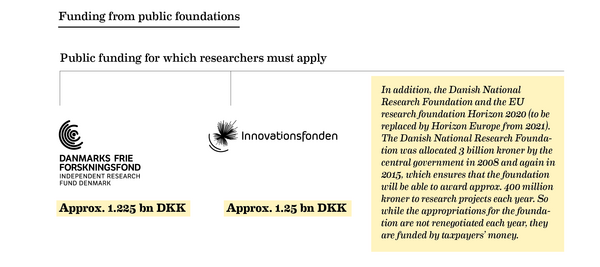
If you’re a researcher interested in getting funding from these foundations, you can write and submit a grant proposal describing your research project. A council or board at the fund decides which research projects are awarded support. This means that you compete with other researchers at Danish universities who want funding for their projects.
This competition for funding has increasingly come to characterise the research landscape over the last decade. According to the research statistics, more and more of Danish universities’ funding is accounted for by sources other than basic funding, which means they must be acquired from other sources, for example the foundations. Whereas about half of the Danish universities’ budgets are comprised of basic funding today, in 2006 the proportion was over two-thirds.
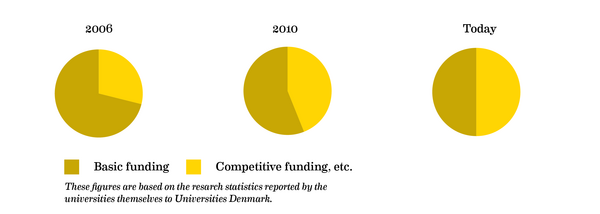
And there’s a battle for every single kroner of competitive funding. In 2017, the four Danish foundations received applications for 34 billion kroner. They had only four billion to award. They received a total of 7,447 grant proposals, of which just 1,523 were successful. Put another way, the foundations were only able to award one in eight kroner applied for, and only one in five applications was successful.
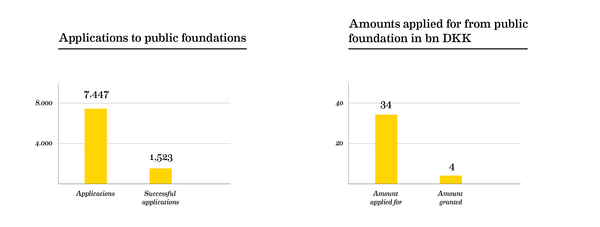
Earmarked and non-earmarked funding
What kind of research the foundations support depends on their mission. The best-known Danish foundation is probably Independent Research Fund Denmark. In 2019, the foundation has 1,225 million kroner to allocate. This funding is not earmarked, which means it must be used for non-targeted research. In the simplest terms, this means that the best research projects get funding regardless of topic. The idea is to ensure the continued development of new research areas and new knowledge.
Now the national politicians have decided to earmark a small proportion of this funding for research within specific areas. In 2019, 100 million kroner out of the total pool of 1,225 million are earmarked for specific purposes by politicians – for so-called themed or targeted research.
This kind of targeted research is the only kind Innovation Fund Denmark supports. The declared mission of the foundation is “to solve societal challenges and strengthen growth and development” – the criteria the foundation uses when awarding grants. If you want to apply for money from this foundation, your research project has to fit into these criteria defined by politicians. In 2017, Innovation Fund Denmark awarded 1,250 million kroner, or slightly more than Independent Research Fund Denmark.
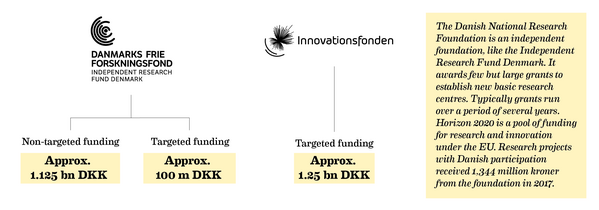
While Independent Research Fund Denmark awards a lot of small grants, Innovation Fund Denmark awards both small and large grants like Grand Solutions. The Danish National Research Foundation and Horizon 2020 award fewer and larger grants.
Private foundations
Researchers have another potential source of funding – private foundations.
A 2016 report by the Danish Agency for Science, Technology and Innovation (now the Danish Agency for Science and Higher Education, ed.) lists twelve of the largest private foundations’ contributions to Danish research in the period 2012-2014. According to the report, the foundations contributed about 9 billion kroner to research and development in this period, just 600 million kroner less than the public foundations.
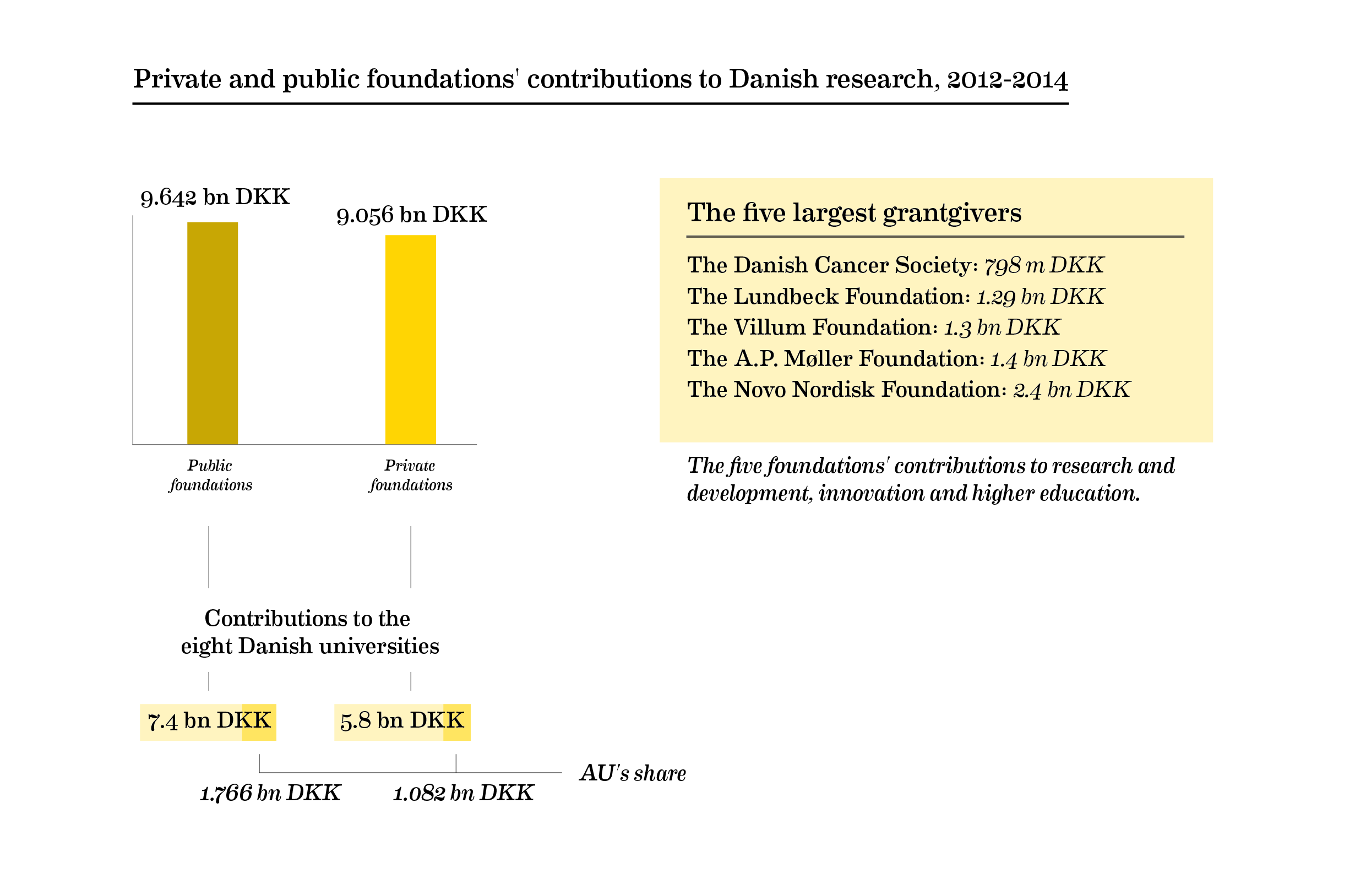
Where does the money go?
Not all research areas benefit equally when the big foundations award grants. The health sciences alone account for almost half of the funding awarded. The natural sciences receive every fifth kroner, while the social sciences have to get by with 6.6 percent and the humanities with 3.4 percent.
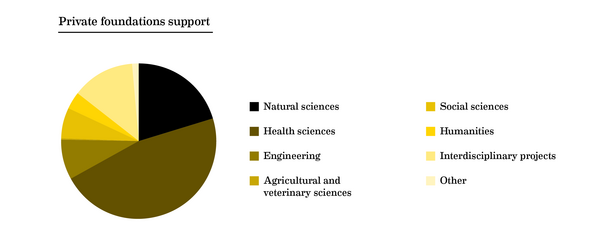
In this period, Novo Nordisk, the A.P. Møller Foundation, the Danish Cancer Society and the Lundbeck Foundation accounted for 84% of private funding to health-related research. Private foundations awarded a total of 4.2 billion kroner to health research. This is over twice as much as the public foundations, which awarded 1.8 billion kroner.
